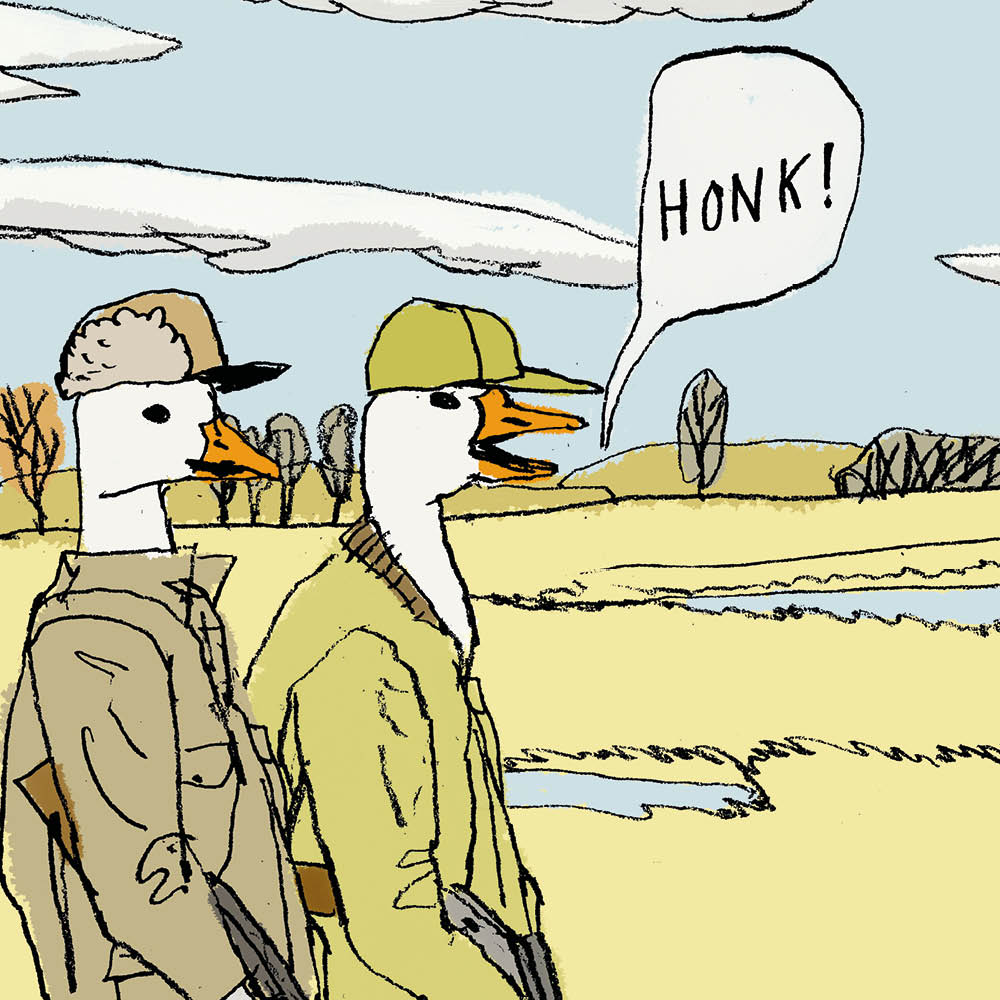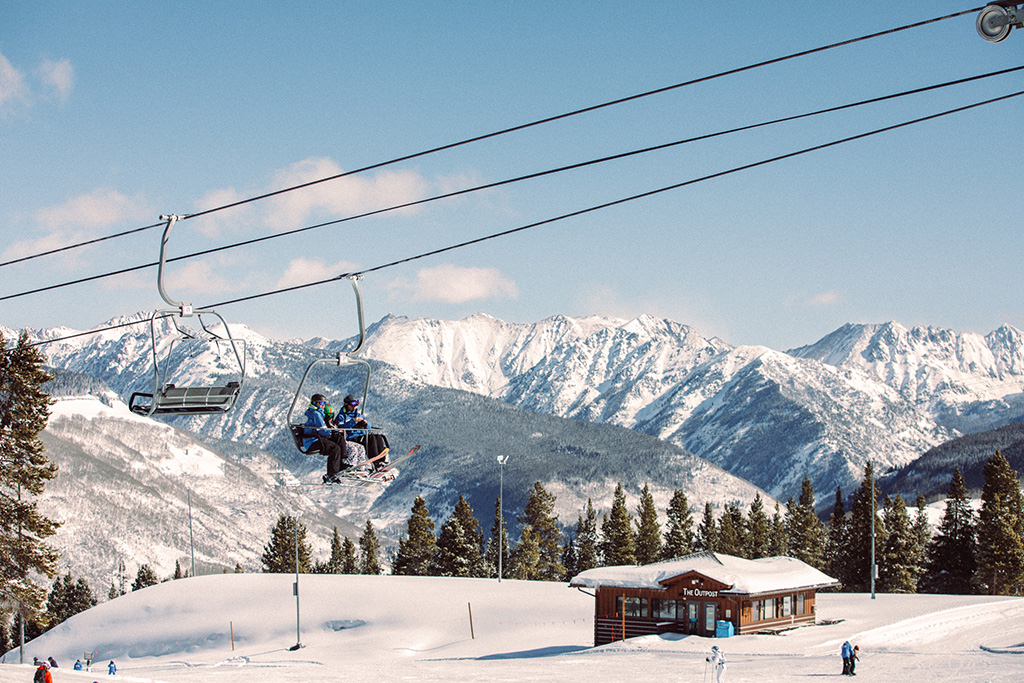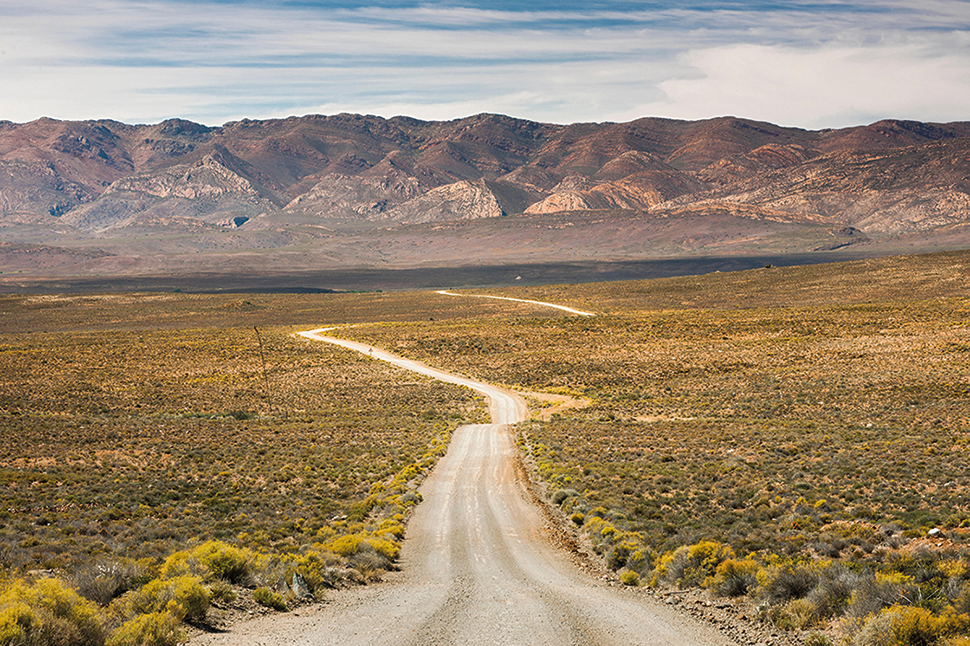It’s a slow Sunday in Paducah, Kentucky, the day before our snow goose hunt. Morning Mass down the road, where the priest quizzingly asked where we were from. Brunch with my husband’s family at a cozy café. Chocolate cake with that crackly boiled icing and fresh coffee in the late afternoon at his aunt and uncle’s house. It isn’t until close to dinnertime that we pack up our bags and hit the road for the bootheel of Missouri, where we will hope to catch a few hours of sleep at our hotel before we meet our local hunting guide.
About halfway through our drive, the phone rings with bad news. Our guide, Scooter, spent the day scouting and could find no signs of geese at his usual spots. There was one flock that had been settling on a nearby farm, but Scooter couldn’t get ahold of the farmer to get us permission to hunt. We had two choices: call the hunt off now or go out anyway and risk not seeing a single bird. We looked up earlier flights home as we passed through Cairo, the eerie, abandoned river town at the southernmost tip of Illinois.
A few minutes later, the phone rang again; Scooter had permission from the farmer. The hunt was on.
I grew up hunting deer and turkey, but had never even heard of a snow goose before my husband informed me that I was joining this trip. Snow geese are subject to a federal conservation order, enacted in 1999, that allows hunters to kill as many as they like during a state’s conservation season. In Missouri, that runs from early February to late April and will cost you $47 for a license. The conservation order came about as a potential solution to a swelling snow goose population, which was having devastating effects on local habitats and farms. Midwestern farmers often plant winter wheat in the fall as a cover crop to prevent erosion and keep the fields arable for the next planting season; a swarm of snow geese can kill off a dozen acres in no time at all. They will rip every plant out at the root and devour the seeds, stems and leaves, destabilizing the land and killing any profit a farmer hopes to make in the off-season.
“The farmers love us. They would probably pay us to get rid of these things for them,” my husband says. This is the real Green New Deal.
With renewed spirit, we stop for fuel at Lambert’s Café in Sikeston, Missouri. A hot piece of bread whizzes past my head and into the outstretched palm of my husband’s teen cousin. He surrenders it to me and I slather the steaming puff in butter. This is my first taste of one of Lambert’s famous “throwed rolls,” a tradition that started in 1976 when the owners’ son couldn’t get the homemade rolls to customers fast enough. In addition to the rolls, which are offered with a dollop of thick apple butter or sticky sorghum, Lambert’s brings around family-style sides to go with the entrees. The drinks (I get sweet tea) arrive at the wooden booth in half-gallon mugs. I barely make a dent in my pot roast.
We retire to our hotel in Hayti, with the hope of conking out at a reasonable hour. Our alarms are set for 2:45 a.m. — I end up with about four hours of sleep. We pop up, get dressed in our camo, pack up our bags and head to the gas station down the road to meet Scooter. There are sixteen hunters total on this trip. After grabbing coffee, we all pile into our pickups and follow Scooter and his loaded trailer to the farmer’s field.
It doesn’t take long for Scooter, a Hayti native with a wind-burned face and a thick Missouri drawl, and his team to start unloading their trailers and put us to work. If we’re going to get everything set up before daybreak, we need to hustle. We’re tasked with littering the field with snow goose decoys while the guides set up the blind.
“If everyone carries seven decoys, it’ll only take three trips to get this done,” Scooter says. For those doing math at home, that means we’re putting out more than 300 of these things. It’s about 25 degrees outside, so I am grateful for an excuse to get moving. We all load up our arms with the plastic decoys — the veterans call them “dekes” — and chase down one of the other guides, who has already shoved a dozen stakes into the muddy ground. It’s still pitch black outside and only some of us have headlamps, so we play a deranged version of follow-the-leader. At a certain point, some of us decide it’s easier to stand in one place and wait for the stake guy, who seemingly moves at random, to criss-cross back in our direction. Work smarter, not harder.
After an hour the dekes are finally done and we migrate back to the blind. The A-frames have been wrapped in canvas and the guides are meticulously camouflaging the outsides with bundles of tall dry grass. The black sky is now deep blue and the horizon is lined burnt orange as the sun threatens to start the day.
“I would’ve had this done twenty minutes ago if I had my whole crew here,” Scooter asserts. “We’re running out of goddamn time.”
We are instructed to grab our guns and gear and enter the blind from the small triangular opening on one end. All sixteen of us sit shoulder-to-shoulder on low stools with our shotguns leaning on the A-frame and boxes of ammo at our feet. There’s a small opening above our heads; that’s where our gun barrels will poke out when it’s time to start shooting. There are rules to the hunt, of course: safeties should be on all guns unless we are actively shooting geese, and we keep our heads down and stay quiet until Scooter gives us the call to start blasting. If someone decides to pop up early, it could ruin the hunt for the rest of us. On a good day, Scooter’s hunters can kill hundreds of geese in just a few hours. Today, the wind is light and the geese seem primed to move further south, so we’re not sure we will even see any.
Everyone gets settled in and starts chattering about what’s to come. I’m not sure if Scooter has gotten wind of the fact that we live just outside Washington, DC, but I hear him proudly declare from the end of the blind, “Down here, Richmond, Virginia is the true capital.”
Our conversations are cut short when one of the other guides turns on the electronic goose calls, which are blasted through speakers placed in the farmer’s field. This is a sign that he has noticed a flock of snow geese close by. If you tilt your head slightly and put your eyes to the sky, you can catch a glimpse of them flying overhead in their signature vee formation. They circle the field, getting a little closer to us each time. It’s a beautiful sight.
Finally, as they prepare to fly directly over the blind, Scooter shouts, “Pull!”
We all hop to our feet and fire into the mass. My gun only holds three shells, but others have outfitted their shotguns with a magazine extension tube or bring two guns with them to fire off as many rounds as possible. It looks like we’ve brought down about ten geese; the rest fly off as we sit back down in our chairs, reload and get ready for the next volley.
As we wait, Scooter bemoans the fact that snow-goose hunting has become a tourist attraction in Missouri: “These damn guides from up in Montana and Wyoming are coming down here and ruining it for the rest of us. Ain’t no land left to hunt. Stay up there and we’ll stay down here. Simple.” The electronic calls come on again; this time the geese come in tight, Scooter calls the shot, and we annihilate the mass. One goose is so close when he gets hit that he crashes down past our heads; we dodge him like one of Lambert’s throwed rolls and he plops into the field just behind our blind.
There is one straggler that the guides manage to call back in, and about a half dozen of us try our hand at taking him down as Scooter shouts, “Kill him!” We all miss somehow. “Good shooting, guys,” my husband ribs as the blind fills with laughter. The goose flies off with its guardian angel.
We have a long break where no geese come, and Scooter is clearly frustrated by the relatively slow day. He gets out of the blind to fix the grass, which has been sliding down the edges of the blind throughout the morning. “I’ve got too many goddamn bobbleheads in this blind,” he rants. “Y’all ain’t gonna kill no geese if you keep popping up and shifting around. Way too much movement.” He seems satisfied when he gets back into the blind and sees that his adjustments have minimized the amount of light getting in, which means the geese are less likely to spot us.
You’d think it would be easy to kill off an awful lot of the population hunting this way, but the snow goose population has only increased since the conservation order was put in place. The things breed like crazy and have incredible eyesight. Waterfowl have the ability to see a wider range of the light spectrum, which helps them more easily discern shapes and movement, and they can see two to three times as far as humans. Too much movement in a blind or wearing the wrong clothing outside of it can absolutely ruin a hunt.
Luckily, it’s not too much longer before another group of geese flies overhead. This time, there are hundreds, if not a thousand, of them. There is something special about getting to be this close to nature, with nature unaware of your presence. It sends a chill through your body. Scooter calls the shot, and I lift my shotgun, aim and pull the trigger. A hole opens up where my steel shot penetrates the flock.
The hunt is called just after 10 a.m. Shots continue to ring out for the next few minutes as the guides finish off the cripples. If you are going to hunt, you must be prepared to commit these small acts of mercy. We respect the animal and treat it accordingly.
At the end of our three-plus hours in the blind, we’ve bagged forty birds. It’s a pretty good haul considering the poor conditions, and the fact that we weren’t even sure we’d be able to hunt today. “Did’ya have fun?” Scooter asks me as I bring back a load of dekes. “It was awesome,” I reply. This will probably be the last group he takes out this season, but we all agree to come back next year. Conservation, it turns out, is addicting.
This article was originally published in The Spectator’s April 2024 World edition.























Leave a Reply